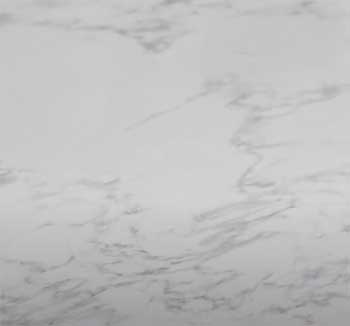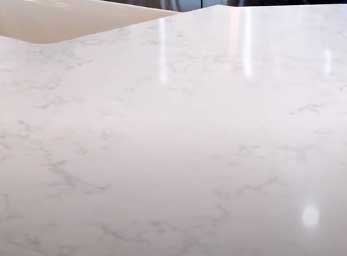Viatera quartz countertops are popular choices for kitchen and bathroom remodeling projects thanks to their stylish aesthetics, durability, and low maintenance requirements.
However, like with any engineered stone surface, Viatera quartz is not without its potential drawbacks. This guide will provide a comprehensive overview of the most commonly reported problems and complaints with Viatera quartz countertops to help homeowners make an informed decision.
Common Problems With Viatera Quartz
Here is a list of those issues:
- Quality Control and Material Variation Problems
- Prone to Staining and Etching
- Prone to Chipping and Cracking Around Cutouts
- Prone to Damage From Thermal Shock
- Prone to Damage from Improper Fabrication and Installation
- Only a 10-Year Limited Warranty
Let’s talk about them in detail:
- Quality Control and Material Variation Problems

One of the most frustrating issues that crops up with Viatera quartz is quality control and material variation problems.
Viatera is manufactured by LG Surfaces, who sources quartz aggregates and blended resins from various suppliers.
This means there can be noticeable differences between quartz slabs that are labeled as being the same color and pattern.
When purchasing Viatera, it’s important to carefully inspect all slabs intended for your project side-by-side to check for differences in veining, fleck sizes, gloss levels, and overall color tone.
There have been reports of customers receiving countertops that look completely different from the sample slab they approved. This lack of consistency can ruin the designer vision for a space.
The aesthetic variations seem especially prevalent among some of Viatera’s most popular earthy tones like beach house, whitewater, and coastline. This makes quality control a vital concern when working with Viatera quartz.
Being aware of the potential material variation issues allows homeowners to take proper precautions when purchasing slabs.
- Prone to Staining and Etching
While quartz countertops are less porous than natural stone surfaces, Viatera is still susceptible to staining and etching under the right circumstances.
Homeowners report issues with oil-based stains causing stubborn discoloration that proves difficult to remove even with commercial-grade cleaners and polishing compounds.
Citrus juices, vinegar, wine, and certain cleaning agents containing dyes can also etch Viatera upon prolonged exposure. These etched spots create a faint matte appearance on the otherwise glossy finish.
Etching may worsen over time as routine cleaning slowly erodes the surface further.
Viatera lacks the superior stain and etch resistance provided by premium quartz brands. So extra care must be taken to wipe up spills immediately, avoid letting moisture sit, and prevent exposing the surface to acidic substances for long periods.
For heavy-use areas like kitchen countertops, Viatera may not hold up as well compared to higher-end engineered quartz.
- Prone to Chipping and Cracking Around Cutouts
Cutouts for sinks, faucets, and other features subject quartz countertops to increased stress that can lead to chips and cracks over time. Viatera’s softer formulation seems especially vulnerable to damage if the cutouts lack proper reinforcement and rounding.

Homeowners report issues with cracks radiating from corners of cutouts for sinks and cooktops.
The cracks may start off small and gradually worsen.
Chipping along the edges of cutouts is also a common complaint with Viatera installations.
These chips allow moisture penetration that can undermine the substrate and cause further separation.
To reduce the risks of chipping and cracking around cutouts, experts recommend choosing an experienced fabricator, reinforcing corners with additional support brackets, rounding internal corners, and taking extra care to avoid bumping or placing excess strain on these high-stress areas.
- Prone to Damage From Thermal Shock
Subjecting quartz surfaces to extreme temperature swings puts them at risk for thermal shock. The rapid expansion and contraction of the material can cause cracks, fissures, and discoloration.
Viatera seems to have below-average thermal shock resistance compared to premium quartz brands.
Homeowners have reported issues with surface damage after exposing Viatera countertops to hot pots and pans straight from the stovetop. Allowing the surface to overheat while using appliances like instant pots, griddles, or crockpots can also damage the resin binder.
To prevent thermal shock damage, it’s essential to use trivets and hot pads when placing hot items on Viatera quartz. Avoid exposing the surface to extreme temperature fluctuations.
Also take care if using heat-generating appliances directly on the countertop. Upgrading to a higher-end quartz formulation provides better heat tolerance.
- Prone to Damage from Improper Fabrication and Installation
Quartz countertops require specialized tools and techniques during fabrication and installation to create perfectly seamless joints and prevent cracks or chips. Viatera’s softer material seems more prone to fabrication errors and damage from improper installation compared to premium quartz.
Homeowners have experienced issues like uneven seams, lippage between quartz slabs, cracks radiating from seams, and corners chipping from being bumped during installation. This damage points to potential problems during the manufacturing or installation process.
To ensure a quality outcome with Viatera quartz, vet your fabricator thoroughly and only use an experienced professional. Closely inspect all seams and joints after installation to confirm proper alignment and structural integrity.
Any damage from the fabrication or installation process should be addressed under warranty.
- Only a 10-Year Limited Warranty
While quartz countertops are touted for their longevity, the quality of the warranty coverage also matters. Viatera comes with a rather unimpressive 10-year limited warranty. By comparison, other leading quartz brands offer 15-year or lifetime limited warranties.
The shorter warranty period underscores concerns about Viatera’s long-term durability and performance, especially in busy kitchen environments. It also provides less protection in the event that any manufacturing or installation defects become apparent over time.
For homeowners making a significant investment into quartz countertops they expect to last for decades, Viatera’s limited 10-year warranty falls short. Other quartz options on the market come with superior assurances backed by longer warranty coverage.
Is Viatera Quartz Still Worth Considering Despite The Potential Problems?
While Viatera quartz has some drawbacks compared to premium engineered stone countertops, it can still be a practical option worth considering for certain homeowners. Here are some reasons why Viatera quartz may still deserve consideration:
- Greater Affordability

The main advantage of Viatera quartz is its relatively low cost. Viatera starts around $50 per square foot installed.
This compares favorably to premium quartz that ranges from $80-150 per square foot installed.
The cost savings of 20-50% can be substantial for larger kitchen or bath remodels.
For homeowners on a tight budget, Viatera provides a chance to achieve a sleek contemporary quartz look that may otherwise be unattainable.
- Sufficient Durability for Light Use
In low traffic areas where daily wear and tear is minimal, Viatera can provide adequate durability. For example, using Viatera quartz on a bathroom vanity or bar surface that sees limited use can avoid potential issues that crop up in busy kitchens.
Viatera also works well for flooring and wall applications. With proper care and maintenance, it may perform sufficiently in certain scenarios.
- Attractive Styling Options
From crisp whites to bold blues, Viatera comes in a wide selection of contemporary colors and patterns. The ranges of lighter soft-toned neutrals and dark broody palettes give plenty of options to achieve on-trend countertop looks.
Viatera’s aesthetic versatility allows it to fit nicely into a variety of design styles.
- Easy Maintenance
Compared to natural stone and marble that requires frequent sealing, Viatera quartz provides a low maintenance alternative. While it is prone to some staining and etching, it does not need regular sealing or polishing.
Just be sure to wipe up spills promptly, avoid exposing it to excessive heat or acids, and follow the manufacturer’s care guidelines.
- Good Value for Rental Properties
For real estate investors outfitting rental properties or flip projects, quartz provides a durable and attractive option over laminates. Viatera can help upgrade kitchens and baths to command top rental prices and sale values without breaking the bank compared to premium quartz options.
Frequently Asked Questions (FAQ)
Viatera provides an affordable quartz option and offers attractive styles. However, overall Viatera sits more towards the lower end of the quality spectrum compared to higher-end quartz brands. Recurring issues with staining, etching, cracking, seam separation, and damage under stress point to some formulation and durability concerns versus premium quartz.
The main drawbacks of quartz countertops apply to Viatera as well. Quartz can etch from acidic substances and stain from oils. It’s prone to chipping around cutouts. Thermal shock can damage the surface. Seams may crack or separate over time if not fabricated properly. With lower-quality quartz like Viatera, these downsides tend to be more apparent.
Quartz quality varies widely based on the purity of the natural quartz aggregates used, ratio of quartz to polymer resins, polymer resin quality, pigments added, and manufacturing processes. Lower quality quartz tends to use less quartz and more resin filler. Viatera sits on the lower end of the quality scale compared to premium quartz brands that use purer quartz and superior resins.
The highest quality quartz countertops come from premium brands like Caesarstone, Cambria, and Silestone. These use over 90% pure natural quartz, high-performance resins, and rigorous quality control. Higher-end quartz offers better stain, scratch, and heat resistance compared to budget options like Viatera. The top brands provide warranties of 15 years or longer.
In Conclusion
Viatera quartz counters provide an affordable option to achieve the aesthetic of natural stone or granite. However, Viatera comes with some inherent formulation issues that make the surface more prone to staining, etching, chipping, cracking, and other damage under daily use and stress.
The softer quartz, lower resin quality, and lack of rigorous quality control result in more variability and performance concerns compared with premium-engineered quartz options. For longevity in busy kitchens and baths, higher-end quartz that better resists damage is recommended.
But Viatera remains a viable lower-cost alternative for those willing to take extra precautions.

